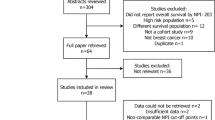Abstract
Very few tumor markers have been recommended for routine clinical care of patients with breast cancer [1]. A framework to determine the clinical utility of tumor markers is required. In a previous publication, a "Tumor Marker Utility Grading System" (TMUGS) was proposed [2]. TMUGS included a semi-quantitative grading scale (0-3+) which can be used to assign a score to a given tumor marker for a given outcome. Only those markers that are felt to be sufficiently strong to influence a therapeutic decision that results in improved clinical outcome for the patient are recommended. The studies from which data are used to assign a TMUGS grade can be placed into one of five Levels of Evidence (LOE).
An extension of TMUGS ("TMUGS-Plus") is now proposed in which the relative strength of a prognostic or predictive factor can be estimated and expressed in terms of a risk ratio (RR) for prognostic factors or benefit ratio (BR) for predictive factors. Three categories of prognostic factors and three categories of predictive factors are proposed (strong, moderate, and weak). It is recommended that only LOE type I studies (prospective, highly powered studies of the tumor marker, or meta-analysis of LOE II or III datasets), be used to estimate the RR or BR of a given factor. Finally, a matrix, based on assumptions of acceptable absolute benefits relative to risks, is proposed in which any given tumor marker can be assessed for its clinical utility.
TMUGS-Plus should aid in the assessment of published data regarding clinical utility of tumor markers. Perhaps more important, clinical investigators can use TMUGS-Plus to design tumor marker studies that will fulfill criteria for clinical utility, resulting in more rapid acceptance of tumor markers for routine clinical use.
Similar content being viewed by others
References
ASCO Expert Panel: 1997 update of recommendations for the use of tumor markers in breast and colorectal cancer. J Clin Oncol 16:793-795, 1998
Hayes DF, Bast R, Desch CE, Fritsche H, Kemeny NE, Jessup J, Locker GY, Macdonald J, Mennel RG, Norton L, Ravdin P, Taube S, Winn R: A tumor marker utility grading system (TMUGS): a framework to evaluate clinical utility of tumor markers. J Natl Cancer Inst 88:1456-1466, 1996
American Joint Committee on Cancer: Breast. In: Fleming I, Cooper J, Henson D, Hutter R, Kennedy BJ, Murphy G, O'Sullivan B, Sobin L, Yarbro J (eds) AJCC Cancer Staging Manual. Lippincott-Raven Publishers, Philadelphia, 1997, pp 171-180
McGuire WL, Clark GM: Prognostic factors and treatment decisions in axillary-node-negative breast cancer. N Engl J Med 326:1756-1761, 1992
Gasparini G, Pozza F, Harris AL: Evaluating the potential usefulness of new prognostic and predictive indicators in node-negative breast cancer patients. J Natl Cancer Inst 85:1206-1219, 1993
Honig S: Treatment of metastatic disease. In: Harris J, Lippman M, Morrow M, Hellman S (eds) Diseases of the Breast, Lippincott-Raven Publishers, Philadelphia, 1996, pp 669-734
Clark G: Prognostic and predictive factors. In: Harris J, Lippman M, Morrow M, Hellman S (eds) Diseases of the Breast. Lippincott-Raven Publishers, Philadelphia, 1996, pp 461-485
Knight W, Livingston R, Gregory E, McGuire W: Estrogen receptor as an independent prognostic factor for early recurrence in breast cancer. Cancer Res 37:4669-4671, 1977
Early Breast Cancer Trialists Collaborative Group: Effects of adjuvant tamoxifen and of cytotoxic therapy on mortality in early breast cancer. N Engl J Med 319:1681-1692, 1988
Early Breast Cancer Trialists Collaborative Group: Ovarian ablation in early breast cancer: Overview of the randomised trials. Lancet 348:1189-1196, 1996
Early Breast Cancer Trialists' Collaborative Group: Systemic treatment of early breast cancer by hormonal, cytotoxic, or immune therapy: 133 randomised trials involving 31,000 recurrences and 24,000 deaths among 75,000 women. Lancet 339:1-15, 71–85, 1992
Albain K, Green S, Osborne K, Cobau C, Levine E, Ingle J, Pritchard K, Schneider D, O'Sullivan J, Hess E, Martino S: Tamoxifen vs. cyclophosphamide, adriamycin, and 5FU plus either concurrent or sequential T in postmenopausal receptor positive, node positive breast cancer: A Southwest Oncology Group Phase III Intergroup Trial. Proc Am Soc Clin Oncol 16:128a, 1997
Fisher B, Dignam J, Wolmark N, DeCillis A, Emir B, Wickerham D, Bryant J, Dimitrov NM, Abramson N, Atkins J, Shibata H, Deschenes L, Margolese RG: Tamoxifen and chemotherapy for node-negative, estrogen receptor-positive breast cancer. J Natl Cancer Inst 89:1673-1682, 1997
Ravdin P, Siminoff I, Harvey J: Survey of breast cancer patients concerning their knowledge and expectations of adjuvant therapy. J Clin Oncol 16:515-521, 1998
Lindley C, Vasa S, Sawyer T, Winer E: Quality of life and preferences for treatment following systemic adjuvant therapy for early stage breast cancer. J Clin Oncol 16:380-387, 1998
ASCO Expert Panel: Clinical practice guidelines for the use of tumor markers in breast and colorectal cancer: Report of the American Society of Clinical Oncology Expert Panel. J Clin Oncol 14:2843-2877, 1996
Trock B, Leonessa F, Clarke R: Multidrug resistance in breast cancer: A meta-analysis of MDR1/gp170 expression and its possible functional significance. J Natl Cancer Inst 89:917-931, 1997
Early Breast Cancer Trialists' Collaborative Group: Tamoxifen for early breast cancer: Overview of the randomized trials. Lancet 351:1451-1467, 1998
Early Breast Cancer Trialists' Collaborative Group: Polychemotherapy for early breast cancer: an overview of the randomized trials. Lancet 352:930-942, 1998.
Rights and permissions
About this article
Cite this article
Hayes, D.F., Trock, B. & Harris, A.L. Assessing the clinical impact of prognostic factors: When is "statistically significant" clinically useful?. Breast Cancer Res Treat 52, 305–319 (1998). https://doi.org/10.1023/A:1006197805041
Issue Date:
DOI: https://doi.org/10.1023/A:1006197805041




